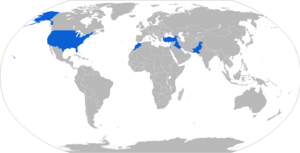This article has multiple issues. Please help improve it or discuss these issues on the talk page. (Learn how and when to remove these messages)
|
| Akrep | |
|---|---|
| Type | Infantry mobility vehicle |
| Place of origin | Turkey |
| Service history | |
| In service | 1994 |
| Wars | |
| Production history | |
| Designer | Otokar |
| Designed | 1990 |
| Manufacturer | Otokar |
| Produced | 1994 |
| Variants | developed from Land Rover Defender 130 |
| Specifications | |
| Mass | 3.6 t (3.5 long tons; 4.0 short tons) |
| Length | 4.19 m (13 ft 9 in) |
| Width | 1.91 m (6 ft 3 in) |
| Height | 2.563 m (8 ft 4.9 in) |
| Crew | 2+6 |
| Main armament | 7.62 mm or .50 inch machine gun on remote weapon station |
| Engine | diesel |
| Suspension | 4x4 |
Akrep ("Scorpion") is a Turkish infantry mobility vehicle developed by Otokar Otobus Karoseri Sanayi AS. The first prototypes were completed in May 1993 and the first vehicles came off the production line in June 1994. In addition to light reconnaissance, the vehicles were used for escort, perimeter control, counterinsurgency, and light attack. The Akrep represented the latest offering in Otokar's portfolio of light vehicles for both civilian and military markets.
Description
The Akrep has an all-welded steel hull with some 70% of its automotive components used from the Land Rover Defender 90/110 (4x4) vehicle. A monocoque steel armor hull protects from small arms fire up to 7.62 mm ball ammunition fired at 90° incidence and point-blank range, and shell splinters. All windows and vision blocks are made of laminated construction armored glass with a polycarbonate liner. The layout is conventional, with the engine at the front, driver and commander in the center, and the machine gun installation mounted on the roof toward the rear with the gunner seated below. The windshield is bulletproof. There are two doors with bulletproof windows at the top and firing ports below. There are also firing ports and viewers on both sides of the hull and a large rear hull door with a firing port that swings out leftward. There is a hatch in the rear section of the roof that opens rearward. The roof gun mount is typically armed with a 7.62 mm machine gun that may be aimed and fired from inside the vehicle. Also there is AGS-17 mounted variants being used in Northern Cyprus.
The mount can traverse 180° left and right and the 7.62 mm machine gun can elevate from -20° to +70°. There are 230 rounds of ready-use ammunition, and an additional 3,000 rounds carried inside the vehicle. The firing is electronically controlled with safety locking and braking together with a mechanical backup. There is also a last round indicator. The day sight has a wide field of view (22°) with 1x magnification and a collimated aiming circle, and a narrow field of view (8°) with 8x magnification and a ballistic graticule. The night sight has a wide field of view (22°) with 1x magnification and collimated aiming circle, and a narrow field of view (7°) with 7x magnification, a 25 mm image intensifier tube, and a ballistic graticule. Standard equipment includes an air conditioning system, a heater and defogger, an infrared driving headlamp, a blackout lighting system, a smoke extraction fan mounted on the roof, thick polyurethane roof and body interior lining for thermal and noise insulation, an explosion-suppressed fuel tank, and Hutchinson run-flat tires. Optional equipment includes a front-mounted electrical winch with 25 meters of cable at a capacity of 3,600 kg, 66 mm smoke grenade launchers, a pioneer kit (axe, shovel, pickaxe), a communications system, and a land navigation system.
The Akrep is relatively light, fast, and maneuverable. Its high power/weight ratio and long travel suspension support mobility in urban conditions, rough terrain, and challenging weather.
Design and manufacture
The Akrep's low profile, ballistic hull design and special armor protection and agility are all designed to maximize its ability to survive in high-threat environments. Each armor plate is laboratory tested and certified. Each panel is stamped prior to production and fully traceable.
All mechanical parts of Akrep are made using commercial off-the-shelf components.
Operators

Current operators
 Algeria
Algeria Bangladesh
Bangladesh
 Georgia
Georgia Kosovo
Kosovo Albania used by RENEA
Albania used by RENEA Iraq
Iraq Israel
Israel Morocco
Morocco Northern Cyprus
Northern Cyprus Turkey
Turkey United States
United States
See also
References
- ^ "Akrep 4x4 Vehicle". Army-Technology. Retrieved 9 May 2014.
- "Institute for National Security Studies > Israel" (PDF). 17 June 2009. Archived from the original (PDF) on 31 March 2010.
| Turkish Army vehicles | |
|---|---|
| Main battle tanks | |
| Armored and wheeled vehicles | |
| Artillery | |
| Missile systems |
|
| Anti-aircraft weapons | |